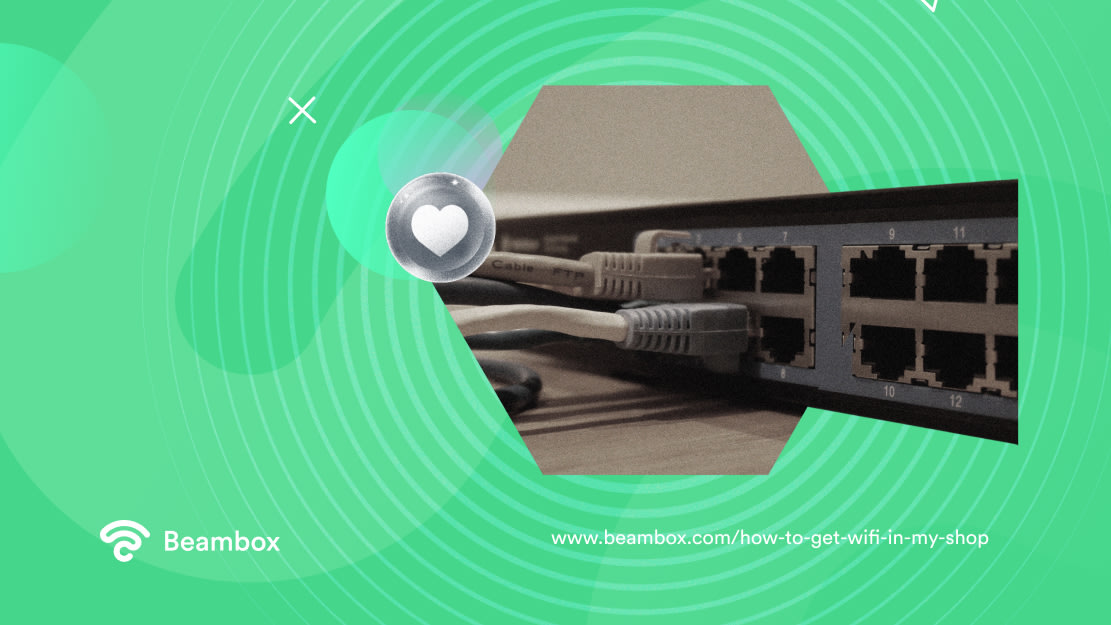Back in the day, you only saw airports and libraries providing free Internet access to the public. But nowadays, it has become a service that customers expect from businesses. Therefore, if you are wondering, “How to get WiFi in my shop?” this article has the answer.
However, it’s not just about the customers. Many businesses now rely on an internet connection for their routine operations. Besides, employees will be happier using free WiFi instead of their data or colleagues’ personal hotspots.
That’s why investing in a reliable WiFi connection pays off, not only for customers but for staff as well. Keep reading if you’re ready to equip your shop with these perks!

Why Public WiFi Is Important for Your Business
Before we reveal the setup process, let’s get one thing straight. You don’t necessarily have to provide free WiFi in your shop if you don’t want to. But remember that it yields unmatched benefits for your business.
The first thing you’ll see after setting up a guest network is increased foot traffic. The prospect of free internet will bring more customers into your shop.
While browsing the internet, they’ll also be browsing your shop. You can turn these browsers into paying customers with the right in-store strategies.
For example, through smart use of WiFi marketing, you can encourage more sales with deals and discounts. Or inform them about your loyalty program. As a result, your shop will be their first choice the next time they need a product you offer.
Apart from increased sales, your public WiFi can yield actionable customer insights for marketing campaigns. These include buying preferences, names, email addresses, etc.
But for that, you’ll have to implement a captive portal. It’s a web page where customers opt into your marketing network in exchange for internet access.
A public WiFi network might also positively change your business operations. It gives you a chance to keep your employees happy and connected. That, in return, might affect how they work for you.
How To Get WiFi in My Shop: 4 Steps to a Reliable and Secure Connection
As people browse and shop, they like to be able to compare prices, gather information, and read reviews.
In fact, 82% of shoppers say that they make purchase decisions in stores using their mobile devices.
Why not take advantage of that by providing free WiFi for customers?
But of course, setting it up isn’t simple, and not following the right steps might do more harm than good. So, here’s how to get WiFi in your shop in four detailed steps.

1. Know Your WiFi Requirements
The first step is to check your requirements. Do you want your WiFi to be completely free for customers, or will their loyalty determine how much access they get?
You also need to decide whether your employees will have unrestricted access. If you want them to enjoy connectivity but fear that they might waste time, you can block certain online activities.
For example, you can let them use social media but block access to streaming sites.
The number of access points you want to install is another aspect that requires your attention. For that, conducting a site survey would be the best option.
More access points mean a fast, reliable connection wherever the user moves.
However, more guest WiFi access points can also mean a much bigger investment. Therefore, you must also consider your budget when gathering these requirements.
Knowing how you want to provide WiFi in your shop will help you choose the right provider.
2. Choose an Appropriate WiFi Service Provider
As you might have guessed from the statement above, the next step is to choose a WiFi service provider.
One of the best options is AT&T, which provides the same upload and download speeds.
However, the quality of service might vary from location to location. Various factors, such as local regulations, geographical features, and technology restrictions, are responsible for this.
Therefore, choose a provider that has the best service in your area. It’s also a good idea to look into their contract terms and security measures. This can save you from falling into hidden fees or legal complications.

3. Get the Necessary Equipment
First, you’ll need a router that is compatible with your internet service provider. However, you have to put some thought into it.
The router you choose must have at least two radio bands: 2.4GHz and 5GHz. The former band is better for longer ranges, while the latter gives you higher speeds. This way, you can set the best frequency for your business.
However, you also have to ensure your public network is secure. There’s already a lot of debate about this, and people have become wary of public WiFi. Therefore, you can’t do without the latest security WiFi protocols like WPA and WPA2.
You should also have the option to create separate primary and guest networks. We’ll touch more on that in the next section.
Apart from a router, you’ll need a modem and an Ethernet cable to connect them.
You might also have to buy additional access points if your shop has a larger area. Some internet service providers send you a technician to set up the hardware.
But even if they don’t, getting professional help to design the network and install the hardware is better.
4. Set Up Both Primary and Guest Networks
While you can set up a primary network and share its password with your customers, it isn’t the best way.
For one, it will give customers access to your shop’s internal resources instead of just the internet connection. As a result, your data will face security threats.
Plus, you might face speed issues since the single network will have to bear a lot of traffic.
So, for the primary network, open your router’s configuration page. You can do this by typing its address, which typically looks like 192.168.1.1.
Once you’re there, log in as an administrator using the credentials on the router. You can also find them in the manual. Then, click Wireless Settings and configure your network by setting up a name and password. Finally, apply the settings, and you’re ready to start using the network.
The process for setting up a guest network is the same as above. The only difference is you’ll find an option for Guest Settings in the Wireless Settings menu. You have to select that before configuration.

Why Public WiFi Hotspots are Worth the Effort
By now, you should know the benefits of public WiFi and how to set it up. But people who ask, “How to get WiFi in my shop?” often question its worth.
Since it requires work and investment, their concern is understandable.
However, free WiFi adds much more to the whole customer experience.
However, if you want to get more benefits out of your WiFi, you should use a WiFi marketing solution. Beambox is an all-in-one WiFi marketing platform that lets you automate marketing activities and grow your online presence. You can use Beambox to get more reviews, grow your social media followings, and gather customer data.
Beambox has no hidden fees and integrates with most internet systems. Try it free for 30 days!
Get Started With Free WiFi Marketing
Beambox helps businesses like yours grow with data capture, marketing automation and reputation management.
Sign up for 30 days free